One of the many reasons why the leopard gecko is so well-loved is its delightfully goofy, ever-present grin. Here are 10 of the best happy leopard gecko smiles, along with some incredible facts about one of the most popular pet reptiles on the planet!
Are you thinking of adopting one of these curious, friendly geckos? If so, then keep scrolling to learn more about Eublepharis macularius while enjoying the most adorable little gecko smiles caught on camera.
1. Leopard geckos can drop (and regrow) their tails!

Leopard geckos can drop their big, bulky tails to distract predators
©iStock.com/CathyKeifer
Many species of lizards are capable of severing their own tails. This is a process known as caudal autotomy, and it is a common defense mechanism for lizards such as leopard geckos.
In the wild, if a leopard gecko is trying to make a quick getaway from an imposing predator, it will quickly drop its own tail before scuttling off. The dropped tail serves as a distraction to the predator, who will likely be a bit confused by the whole ordeal.
Eerily, the muscles and nerve endings in the severed tail cause it to twitch and move on its own for several hours after it was originally dropped, making it a creepy and startling event to unsuspecting predators (or unaware reptile owners!).
Over time, the stump left over from the dropped tail will grow back and form a new tail. However, the regrown tail usually looks a lot different from the previous one as far as its color, shape, size, and pattern.
2. Leopard geckos are strict insectivores.
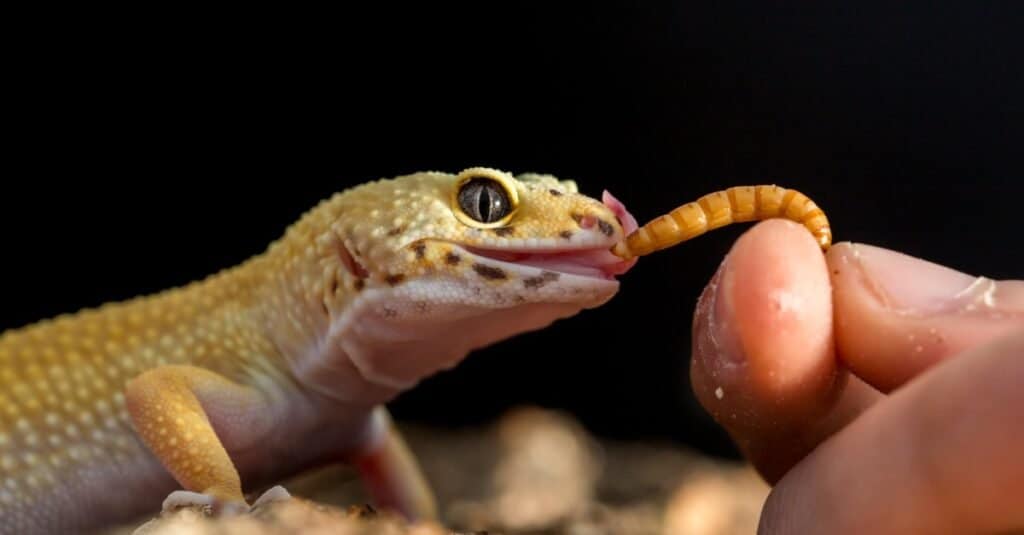
This happy leopard gecko is excited to munch on a mealworm!
©iStock.com/MattiaATH
While many reptiles are omnivorous or strict herbivores, leopard geckos are almost 100% insectivorous. Both in the wild and in captivity, leopard geckos prefer to eat small insects such as crickets and mealworms, though they will also occasionally eat other small invertebrates like spiders and scorpions in their native desert and scrubland habitats.
Very rarely, wild leopard geckos will hunt small rodents and even other, smaller lizards. Fortunately, this only occurs if the gecko is very desperate and/or starving.
As pets, leopard geckos mostly eat feeder insects. These feeder insects are born, bred, and raised in captivity under strictly controlled conditions. This lowers the transmission of parasites and illnesses, leading to longer lifespans amongst captive geckos compared to their wild cousins.
3. There are currently over 100 unique leopard gecko color morphs available on the market.

These happy leopard geckos are showing off their unique colors and patterns made possible by selective breeding
©iStock.com/Dejae ODell
Since the mid-1970s, reptile breeders have plucked leopard geckos from their native habitats, in turn breeding and selling them all over the world. This is largely thanks to the geckos’ small size, adorable appearance, and friendly, curious personalities, which made them ideal pets.
Thanks to several decades of careful selective breeding, there are now more than 100 different color and pattern variations of leopard geckos. These variations are known as morphs. They range in color from yellow, orange, brown, and red to even more unusual colors such as white, grey, and black. Their patterns vary significantly as well, from the typical uniform black spots to stripes, swirls, and even no spots at all!
The tan, spotless leopard gecko above is a perfect example of a morph that did not originally exist in the wild. Without careful, responsible breeders, these unique variations wouldn’t be possible naturally!
4. Leopard geckos sometimes eat their shed skin to reabsorb its nutrients.

This giddy gecko seems to have missed a spot of shed skin stuck to its nose!
©iStock.com/LivingThroughTheLens
All reptiles shed their skin in some way, including leopard geckos. They typically shed their skin all in one piece, which they slowly peel off of their own bodies by rubbing themselves against rough surfaces and using their mouths to remove it. The whole process usually only takes around 10 to 30 minutes and is fascinating to observe from start to finish.
Although the idea of eating dead skin doesn’t sound particularly appetizing, it’s a great way for a leopard gecko to reabsorb essential vitamins and minerals. Many leopard geckos will often munch on their shed skin, both out of survival instinct (to prevent predators from picking up their scent) and to avoid wasting a rich supply of nutrients.
5. Leopard geckos don’t have sticky pads on their feet like most gecko species do.
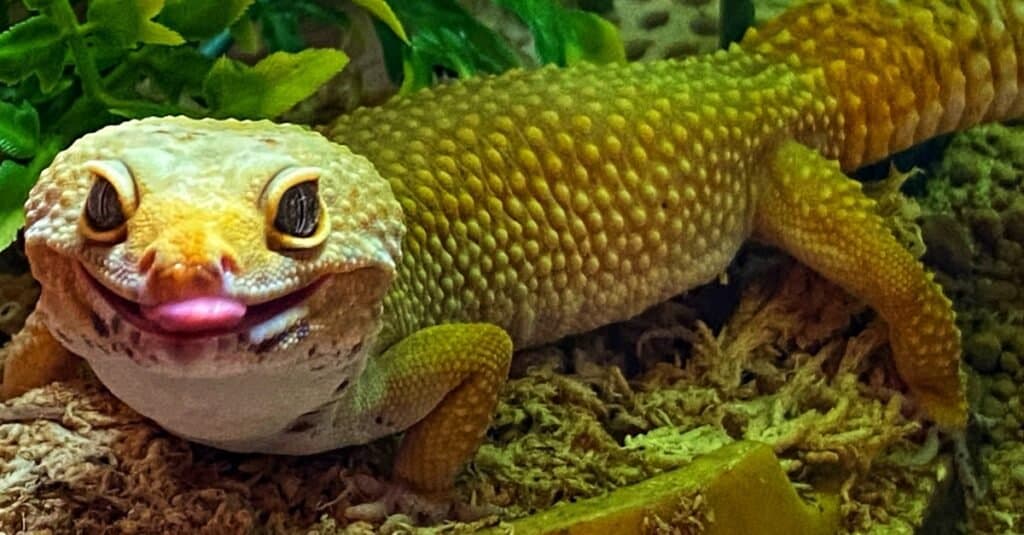
The fact that it can’t climb up walls definitely isn’t slowing this grinning gecko down a bit!
©iStock.com/Samantha Dunn
The vast majority of gecko species can climb up flat surfaces and stick to them with ease. This is thanks to the millions of tiny, sticky hairs known as setae on their toe pads.
Interestingly, leopard geckos have claws rather than these sticky toe pads. The reason for this is mostly evolutionary. Because they are terrestrial, or ground-dwelling, leopard geckos don’t have much of a need to climb up surfaces in the wild. Additionally, their native habitats in the Middle East are mostly flat and lack tall, lush plant cover, so sticky toe pads aren’t necessary for leopard geckos to get around.
Instead, their little claws help them traverse the sandy, rocky terrain common throughout their habitats in countries like Iran, India, and Pakistan.
6. Leopard geckos have movable eyelids, unlike most gecko species.
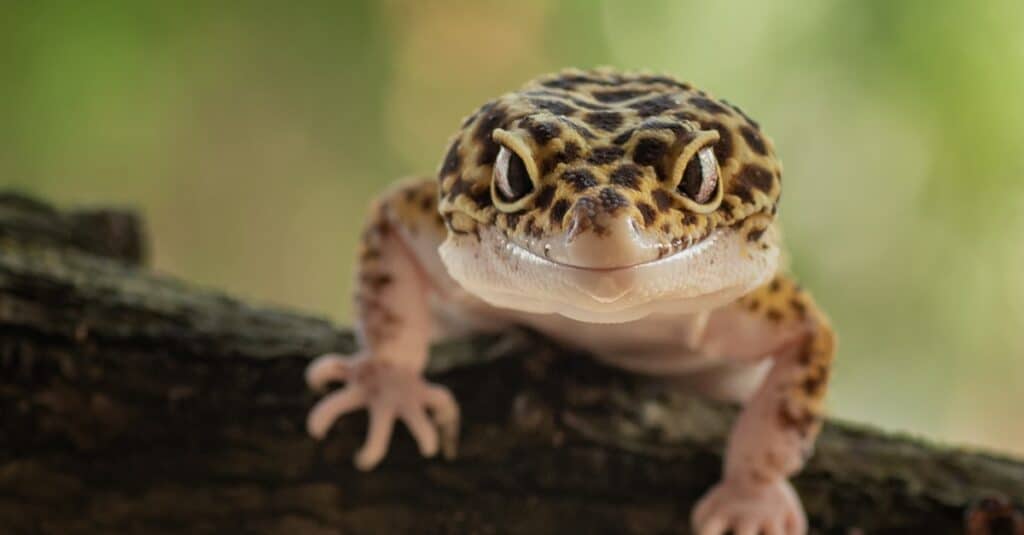
A happy leopard gecko smiles at the camera; check out those huge eyes!
©iStock.com/DikkyOesin
Another feature that sets leopard geckos apart from most other gecko species is their movable eyelids! While most geckos have a single clear scale that covers each eye and shields them from debris, leopard geckos have fully functional eyelids that they can control when blinking or sleeping.
These eyelids help to keep sand and other debris out of their eyes while on the move. This also makes them one of the few gecko species that can blink (and wink!). Their scientific name, Eublepharis macularius, reflects this; “eublepharis” translates to “real/true eyelids,” while “macularius” translates to “spotted,” referring to the leopard gecko’s distinctive spots.
7. Leopard geckos can live well into their twenties!

This smiling gecko could live for 20 years or more!
©iStock.com/Nynke van Holten
Despite their small size, leopard geckos have surprisingly long lifespans. If you’re thinking of adopting one, be aware that they typically live for around 10 to 15 years! It’s also becoming more common for captive leopard geckos to live well past this estimate. Many individuals have reached 20+ years of age!
There are rumors of many individuals living into their late twenties and beyond, though these are rare and mostly unconfirmed. Allegedly, a female gecko in Germany recently turned 40, and a male gecko (location unknown) lived to be 28! Unfortunately, these reports are dubious and should be taken with a grain of salt.
8. A leopard gecko’s sex is determined by the temperature at which their eggs were incubated.
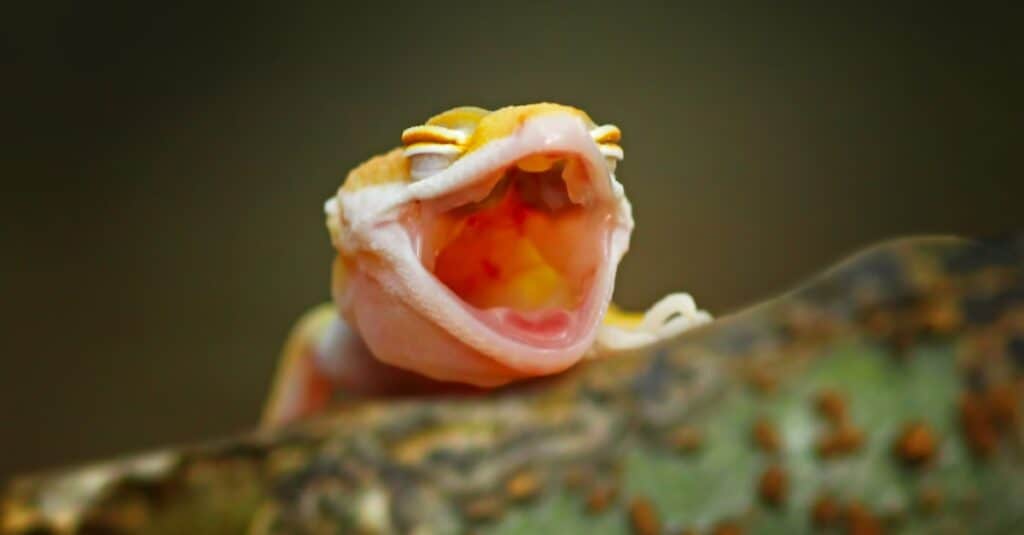
This baby leopard gecko’s sex was determined by how warm its egg was during incubation
©iStock.com/agus fitriyanto
Many reptile species’ sexes are determined by the temperature of their eggs during incubation! This includes leopard geckos. Breeders discovered that eggs incubated at lower temperatures, or around 80 to 84 degrees Fahrenheit, result in female geckos, while eggs incubated at higher temperatures, or around 86 to 90 degrees, result in male geckos.
This unique quality makes it easy for breeders to produce entire clutches of solely male or solely female lizards.
9. Leopard geckos have a wide range of vocalizations with unique meanings.
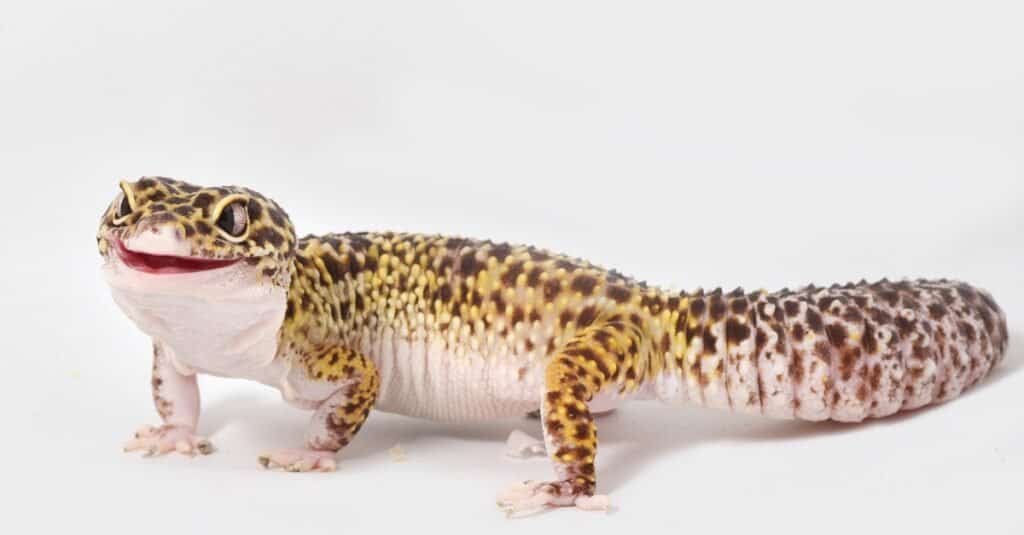
Leopard geckos can produce all kinds of adorable vocalizations from chirps to squeaks and screams!
©iStock.com/DikkyOesin
Although leopard geckos are usually fairly quiet animals, they are able to produce an array of interesting vocalizations. These vocalizations range from squeaks to chirps and even barks and screams!
Leopard geckos’ sounds can mean anything from contentment, anger, fear, or even interest in a potential mate. If you listen closely to your gecko, you might just be lucky enough to hear an occasional chirp or squeak!
10. Leopard geckos have great night vision.
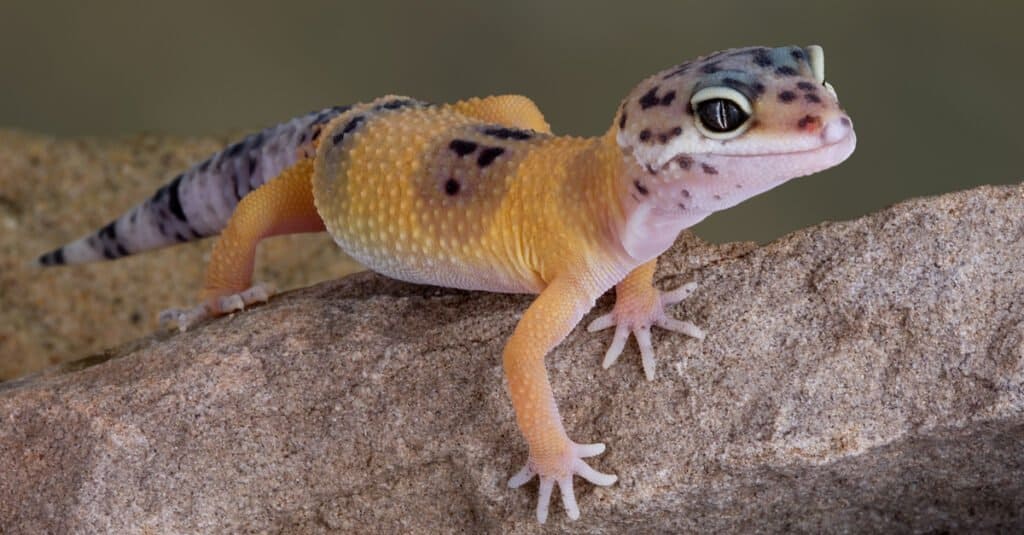
This happy leopard gecko’s large, striking eyes allow it to see perfectly at night
©Cathy Keifer/Shutterstock.com
Leopard geckos are mostly active at night or in the early morning before the sun rises. As a result, they have evolved to have excellent eyesight, especially in low light conditions.
Amazingly, these unique geckos are able to see distinct colors and a surprising amount of detail both in well-lit and poorly-lit conditions! They can see far better than us humans can thanks to their big, bulging eyes and highly sensitive retinas. Their extraordinary eyesight helps them to evade predators in the wild. Plus, their keen vision makes it easy for them to find prey like insects and other small invertebrates.
The photo featured at the top of this post is © iStock.com/CathyKeifer
Thank you for reading! Have some feedback for us? Contact the AZ Animals editorial team.






